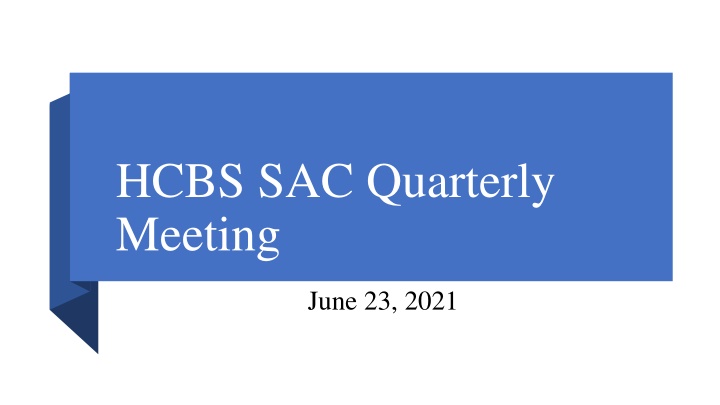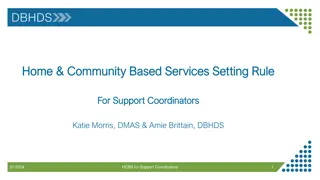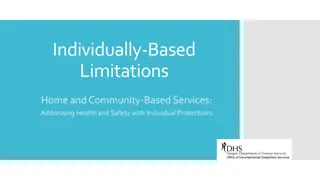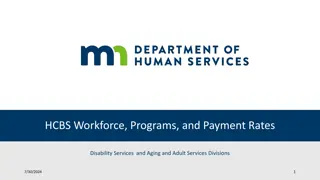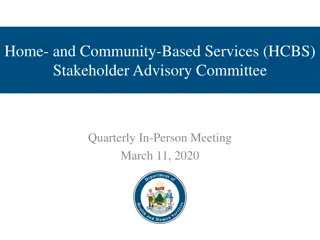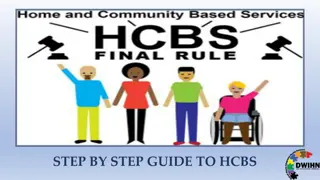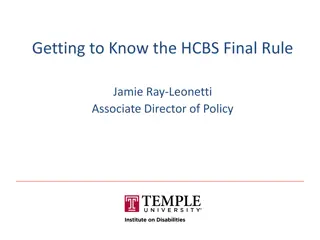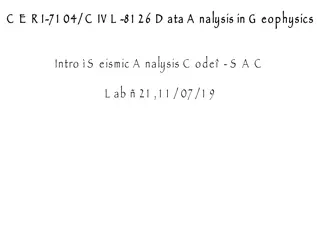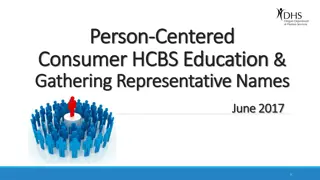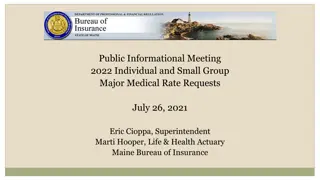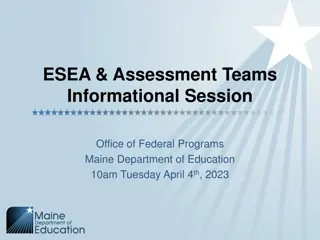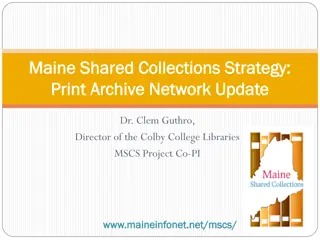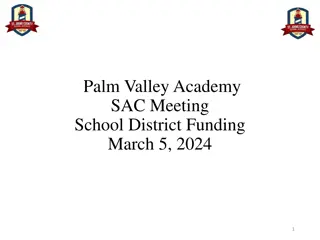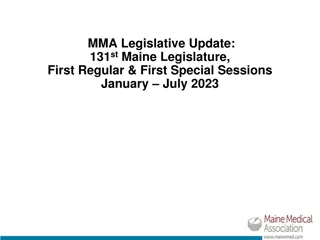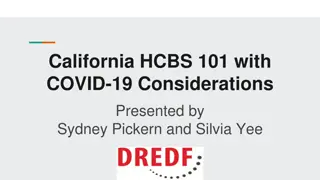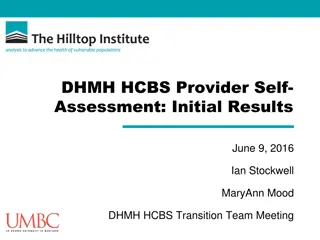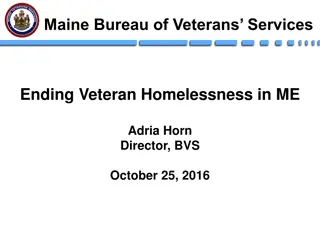Maine's HCBS SAC Quarterly Meeting Insights
An overview of Maine's HCBS Stakeholder Advisory Committee quarterly meeting held on June 23, 2021. The agenda included updates, person-centered planning discussions, policy insights, and feedback from self-advocates on the importance of person-centered approaches in Medicaid HCBS programs. Key topics addressed licensing rule requirements, conflict resolution with HCBS settings, and enhancing choice and control in PCP processes.
Download Presentation

Please find below an Image/Link to download the presentation.
The content on the website is provided AS IS for your information and personal use only. It may not be sold, licensed, or shared on other websites without obtaining consent from the author.If you encounter any issues during the download, it is possible that the publisher has removed the file from their server.
You are allowed to download the files provided on this website for personal or commercial use, subject to the condition that they are used lawfully. All files are the property of their respective owners.
The content on the website is provided AS IS for your information and personal use only. It may not be sold, licensed, or shared on other websites without obtaining consent from the author.
E N D
Presentation Transcript
HCBS SAC Quarterly Meeting June 23, 2021
Welcome: Linda Lee, HCBS SAC Co-Chair 2:00-2:10 p.m. HCBS Update Questions: Heidi Bechard, OADS 2:10-2:25 p.m. Person-Centered Planning: Gail Fanjoy, PCP Subject Matter Expert, EconSys 2:25-2:50 p.m. Erin Smith, PCP Subject Matter Expert, Inclusa 2:50-3:05 p.m. Wrap up, agenda suggestions for 9/22 meeting, etc. 3:05-3:30 p.m. AGENDA
HCBS UPDATE FEEDBACK?
QUESTION TO SAC? Do you have examples of licensing rule requirements that you are concerned may be in conflict with the HCBS Settings Rule requirements?
PERSON CENTERED PLANNING SECTIONS 21 & 29 Gail Fanjoy, EconSys PCP Subject Matter Expert
AN OVERVIEW OF MAINES DRAFT PERSON-CENTERED PLANNING PROCESS AND INSTRUCTION GUIDE Presented to: Stakeholder Advisory Committee 06/23/2021
Why Person Why Person- -Centered Centered? POLICY: Changes in requirements and principles outlined in the Home and Community Based Services (HCBS) Final Rule on Settings & PCP CMS specifies that service planning for people in Medicaid HCBS programs is developed through a person-centered planning process, is directed by the person to the fullest extent possible, includes individually identified goals and preferences, assists the individual in achieving personal goals in the most integrated community setting, ensures services reflect personal preferences and choices, ensures that providers of HCBS for the individual must not provide case management or develop the person-centered service plan. Most importantly, it offers choices to the individual regarding services and supports the individual receives and from whom.
Why Person Why Person- -Centered? FEEDBACK FROM SELF-ADVOCATES: Desire for self-determination and change Centered? Self-advocates cannot identify a specific tool that is being used in their PCP meeting. PCP process needs to be updated to provide more choice and control in their lives. Case Managers need more training around real goal setting. Tools used during the PCP process should be age appropriate. Preference for Charting the Life Course Materials which provide more areas of life experience focus that self- advocates want discussed in their PCP. Concerns that plans are not always followed by support agencies; would like checks and balances built into the process on a regular basis to ensure goals can be adjusted if something is not working.
Why Person Why Person- -Centered? Centered? A UNIVERSAL GOOD LIFE : Incorporate a framework to help individuals develop a vision of a good life Family Intimacy Respect, honesty & fairness Contributing Being treated as an individual Having a say Access to community places Ordinary social life Home Good health Belonging Friends Work Safety and security Opportunities to develop one s abilities
Universal Good Things In Life: Universal Good Things In Life: Maine s Quality of Life Domains: Maine s Quality of Life Domains: Career Planning What a person is doing to work, pursue a career, and earn money. Can include internships, mentoring opportunities, career planning, apprenticeships, job training, paid employment, and employment-related supports (natural or paid). Work Employment Employment Services/Supports Contributing Access to community places Community Access Involvement in the give and take of community life; building and maintaining valued roles; volunteering and contributing to the community; interacting with community members over shared interests. Includes a focus on community access; roles/interests; and service/volunteerism. Community Engagement Interests/Roles Service/Volunteerism Respect, honesty, fairness Being treated as an individual Having a say Communication (Expression, Emotion, Technology) Advocacy Accessing appropriate communication supports to assure the person s words and actions are understood; ongoing optimal engagement of the individual in making decisions and controlling their own lives. Also includes making choices, setting goals, assuming responsibility and driving how one s life is lived. Communication & Advocacy Civic Engagement Living Arrangements/ Options Where and how someone lives housing and living options, environmental safety/emergency planning, home accessibility adaptations, and daily routines. Home Environmental Safety / Home Adaptations Home and Housing Daily Routines 10
Maines Quality of Life Domains (2): Maine s Quality of Life Domains (2): Universal Good Things In Life: Universal Good Things In Life: Activities related to learning and personal enrichment, to include courses, trainings, mentorships, life coaching, personal development, and life-span planning (e.g., retirement planning).Includes consideration of learning style(s), formal and informal educational options and interests, and educational supports. Opportunities to develop one s abilities Learning Style Education / Interests Lifelong Learning Supports Individual and Family Life Building friendships and relationships, leisure & recreational activities, personal relationships, social networks, and including a faith community if desired. Family Belonging Friends Intimacy Having an Ordinary social life Personal Relationships Social & Relationships Leisure and Recreation Faith/Cultural Community Includes managing and accessing health care and staying well (medical, developmental, behavioral health), fitness and nutrition, and disability- or diagnosis-specific health needs/wishes. Healthcare Good health Nutrition and Fitness Health and Wellness Disability/Diagnosis Specific Staying safe and secure mitigating risks, well-being, guardianship options, legal rights and decision making, and financial resources and supports. Personal Safety Safety and security Public Safety Legal and Decision Making Finances Safety & Security
WHAT will be learned: who a person is, including their strengths and capacities, what is important to the person, including their vision for a good life, and specific goals related to that vision which they want to work toward achieving at this time. EXPLORATION EXPLORATION AND AND DISCOVERY DISCOVERY HOW it will be explored: interview and conversation, observing and spending time together, talking with people who know the person well.
TOOLS IN THE CASE MANAGERS TOOLBOX: Charting the LifeCourse Exploratory Questions in each Quality of Life Domain, A Perfect Week Pattern of Current Daily Life Presence to Contribution Map Important To/Important For Communication Profile/Chart Relationship Map/Circle Mapping Relationships Reciprocal Roles Supported Decision Making Tools EXPLORATION AND DISCOVERY TOOLS
Discovers, captures and documents: who the person is a vision for a future life a picture of who the person is now strengths, capacities, gifts and talents relationships important to the person how they spend time together communications preferences (including but not limited to Assistive Technology) valued social roles in the community supports and needs in order to be healthy and safe needs, desires and new things to learn GETTING THE GETTING THE LIFE I WANT LIFE I WANT It does not contain: Diagnoses and other labels Sensitive issues Medical and/or behavioral interventions A recap of all previous jobs and day programs
THE PCP MEETING THE PCP MEETING Resources to Guide Discussion: The Five Valued Experiences & Accomplishments Sharing ordinary places Growing in relationships Experiencing respect; having valued social roles Contributing Making choices and having control over one s life Vision Map Questions for Reflection on Quality of Vision Does the vision reflect a life as belonging to the services system, or is the vision one in which the person has a life equal to other community citizens? Is the vision a community life or a services system life? Work and meaningful activities Their own home Friends and relationships that include people not paid to be with them or other service recipients Contribution in community life valued social roles; opportunities for community members to appreciate the person s gifts and talents
Imagine your experience Imagine your experience running this gauntlet running this gauntlet with a list of your with a list of your strengths, preferences, strengths, preferences, personal goals, and a personal goals, and a vision for a good life in vision for a good life in your hand? What your hand? What changes? changes?
DRAFTING THE PCP DRAFTING THE PCP Based on what is learned through Comprehensive Assessment informed by Exploration & Discovery, the PCP must: Be understandable to the person; written in plain language. Clearly indicate the person s strengths, preferences, and abilities. Easily identify what is Important To the person across Life Domains. Draft individual goals and/or desired outcomes using a SMART goal framework (is it specific, measurable, achievable, realistic, and timely?). Identify the services and supports (paid and unpaid) that will assist the individual to achieve identified goals. Communicate risk factors and measures in place to minimize them, including individualized backup plans and strategies when needed. Document any modifications to the person s HCBS Rights. Identify the individual responsible for monitoring the plan.
The Provider Action Plan must: Detail how the provider will assist the person to pursue their goals and how progress will be measured. Describe how supports and services will: provide opportunities to seek employment and work in competitive integrated employment, if desired. assist the individual to strengthen natural supports and engage in community life, maintain maximum control over personal resources, Demonstrate that services and supports are linked to the person s strengths, preferences, and support needs. Identify all services and supports to be provided including type, frequency, duration, scope and staff assigned (if applicable). Include a review of Reportable Events, IST's, Safety Plans, PSPs, BMPs, or HCBS Right Modification Addendums. Include the justification for any modifications that limit the person's choice, access or otherwise conflict with HCBS standards. Reflect ongoing review, monitoring, and updating, if necessary, by the provider. Be updated to reflect changes in the PCP at least annually and more often if warranted by circumstances, a change in functional status, or at the request of the individual. PROVIDER PROVIDER ACTION ACTION PLANS PLANS
Case Manager monthly check-ins Check in with the person on status of plan, including satisfaction with services, progress in achieving goals, identification of any unmet needs and interim plans for resolving gaps in supports. Ongoing exploration and discovery activities During in-person visits, schedule ongoing exploration & discovery as needed to encourage increased experiences in order to update Comprehensive Assessment. 90 day PCP reviews Connect with providers to determine the person s progress in accomplishing goals, development of natural supports and community membership, and general implementation of the Provider Service Plan. Connect with the person to determine satisfaction with activities, paid supports and services, and settings/providers. MONITORING, MONITORING, 90 DAY 90 DAY REVIEWS, REVIEWS, ANNUAL ANNUAL PLANNING PLANNING Resources & Tools: 4+1 Questions Satisfaction Surveys
PERSON CENTERED PLANNING ROLES AND RESPONSIBILITIES PERSON CENTERED PLANNING ROLES AND RESPONSIBILITIES CASE MANAGER: PAID SERVICE PROVIDER(S): Establishes eligibility for MaineCare services (BMS-99) Responds to vendor calls. Schedules exploration and discovery activities to identify the person's interests, preferences, strengths, and goals as part of the Comprehensive Assessment. Upon receipt of relevant components of a person s PCP, discusses person s goals with the case manager with the intention of developing specific strategies to meet them. Orients the person to the PCP process. Develops implementation objectives using a SMART goal framework. Writes and shares a draft personal profile with the person and his/her allies. Meets with the person, their case manager, and PCP team to finalize the provider action plan. Prepares for the PCP meeting; supports the facilitator. Contributes to on-going exploration and discovery activities; uses findings to support the person s vision of a good life. Drafts the PCP. Provides services to the individual that supports the person s goals and preferences with regard to: community presence and belonging, the development of relationships with typical community members, the development of socially valued roles, contribution to their communities through employment and volunteerism, and increased choice and control. Conducts vendor calls. Hosts calls/dialogues with selected provider(s) and team members to finalize provider action plans. Conducts monthly check-ins, on-going exploration and discovery, and 90 day reviews. 20
Contact Information Lisa A. Mills, PhD Lead Subject Matter Expert Economic Systems, Inc. lisamills@mtdd.onmicrosoft.com Gail Fanjoy Subject Matter Expert Economic Systems, Inc. gmfanjoy@gmail.com 21
Person Centered Planning Section 19 LTSS Erin Smith, Executive Director of Community Resources/Provider Relations, Inclusa, Inc.
Person Centered Planning in Maine Section 19-LTSS PCP Transformation 2 2 23 3 3 Vision All people have the right to live, love, work, learn, play and pursue their dreams in their community- Helping Mainers Live a Good Life Approach and Timelines There is strong commitment to create learning and support resources that will make PCP part of the everyday work. Operationalizing It s all in the approach. While the tools and resources are necessary, the approach is what will make this transition a success.
PCP Transformation-The Building Blocks How does it all fit together? 2 2 24 4 4 PCP Manual Training Quality Measures Resources Implementation The measures to determine how the PCP transformation is going will be outlined in the initial and on-going training. The foundation of it all. It drives the training, and encompasses the approach, resources and tools for success. Focused on competency and skill building. Curriculum will be developed based on the PCP Manual. Think of these as tools in the toolbox. The resources are supports to you, but how you use them is the important part. Strong commitment to success and on-going support
QUESTIONS FEEDBACK WRAP UP AGENDA TOPICS FOR SEPTEMBER 22, 2021 MEETING
